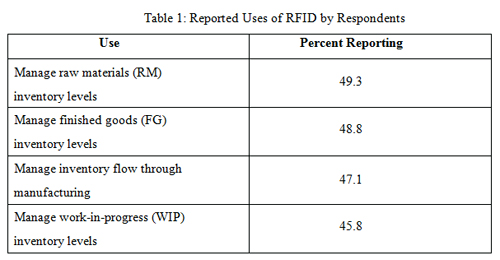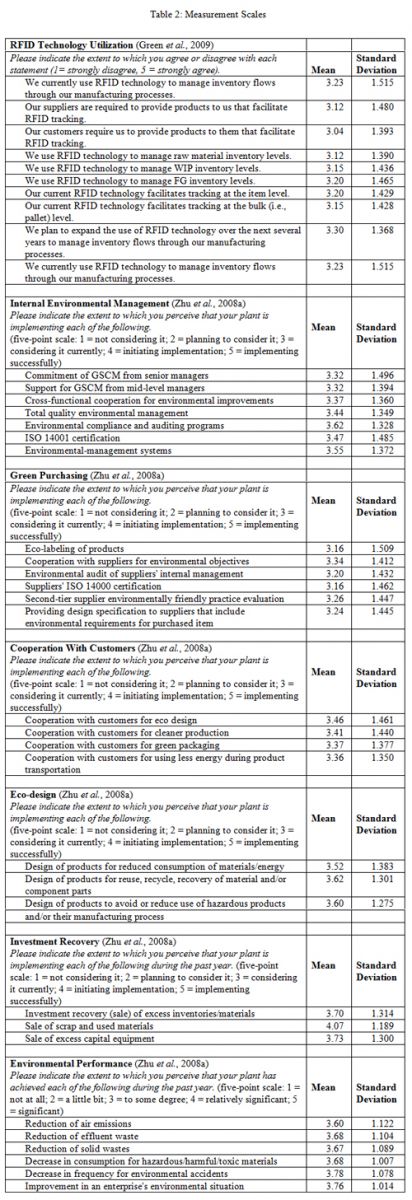A research team at Sam Houston State University‘s Center for Innovation and Technology and Southern Arkansas University recently completed a study that found the use of radio frequency identification technology can improve environmental sustainability, by providing more accurate and timely information to an organization’s green supply chain management practices.
RFID is a technology most often associated with improving manufacturers’ ability to manage assets, inventory and the supply chain. In these areas, RFID has helped manufacturers reduce cycle times, decrease safety-stock levels and improve changeover times (Zebra, 2011). But the technology’s ability to provide near-real-time information also has promise for aiding in environmental sustainability practices. Among the reported benefits in this area are an increased ability to account for, repair and reuse shipping containers returned through the supply chain, as well as an improvement in tracking forest products throughout their life cycle.
The Impact of RFID Tags on Recycling
Some contend that RFID is actually an impediment to environmental sustainability, since RFID tags can be a source of contamination that increases recycling costs. A RAND study (Schindler et al., 2012) has found that it “is not feasible to selectively extract RFID tags” attached to recyclable materials from waste streams during the recycling process. “The impact that is created by an RFID tag depends on whether the waste stream is already heterogeneous or the single object it is attached to is already complex… [and also] on the type of treatment process required.” For example, since most waste streams contain multiple sources of impurities, and the treatment processes are designed to cope with these impurities, “the materials in waste streams may also be those that would be found within the RFID tags. So, passive RFID tags do not necessarily lead to the input of different materials than other applications.”
The Schindler study found that “the impacts of RFID tags on secondary raw material provisioning processes, including metal, glass, paper, plastic and beverage carton recycling, are varied. The metal recyclates and alloying elements expected from RFID tags are copper, silver, nickel and silicon. Of these only copper is considered to be problematic and particularly so in the recycling of non-ferrous metals through the aluminum recycling route. However, the copper recycling route of non-ferrous metals is not only considered to be unaffected by the presence of RFID tags, but also poses the most promising way of recovering both the energy content as well as most metals (especially the precious metals) contained in RFID tags.”
That study also suggested that the waste created by RFID tags presents problems during the recycling process. However, this conclusion is based on a few faulty assumptions. The first is that RFID tags contain a large volume of material that cannot be recycled. According to Chris Diorio, Impinj‘s chief technology officer and co-founder, the fact that it is not feasible to extract tags from recyclable material makes little difference to the waste stream. This is due to the volume of integrated circuits (ICs) present in the waste stream. “…62.5 billion ICs will fit into a cubic meter of waste. The 2013 RFID IC volume will be only 3 billion, which is 0.05 cubic meters of waste. The 2025 IC volume will be 100 billion, but the ICs will be even smaller. So in 2025 RFID ICs will contribute roughly a cubic meter of waste to the worldwide waste stream per year. This amount of waste is inconsequential” (Diorio, 2013). The second faulty assumption relates to the use of copper in RFID inlays. According to Diorio, “Very few inlays use copper today, and the cost of copper means that none will be using copper a few years from now.”
So, if the expected effect of RFID tags on recyclable waste is not likely to be a significant problem if addressed properly, can the technology’s use benefit environmental performance? Prior to the current study, there had been only a single study conducted of RFID’s effect on environmental performance. That study (Bjork et al., 2011) found that RFID improved the forest products industry’s environmental performance by facilitating the tracking of such products throughout their life cycle. The current study, carried out by a research team from Sam Houston State University and Southern Arkansas University, surveyed 225 manufacturing managers within a broad spectrum of manufacturing industries. It indicates that RFID usage is an important contributor to the effectiveness of an organization’s green supply chain management practices. The reason? RFID’s ability to provide more accurate and timely information throughout the supply chain.
The Survey
Respondents were first asked about how they employ RFID technology within their organizations. This information is contained in Table 1. Most respondents reported more than one use.

Approximately half of the respondents reported using RFID at the item level, while about half reported tracking at the pallet or bulk level. About 45 percent said they require suppliers to provide RFID-tagged products, while another 45 percent indicated that their customers require them to provide RFID-tagged products.
The survey next asked multiple questions about five dimensions of green supply chain management practices: internal environmental management, green purchasing, cooperation with suppliers, eco-design and investment recovery (Zhu et al., 2008). Table 2, on the following page, shows our measurement scales—the statements to which people responded in the survey.

Click here to view a larger version of the above chart.
Internal Environmental Management
To assess aspects of the respondent organizations’ implementation of internal environmental management, we asked respondents to rate (on a scale of 1 to 5) seven statements regarding their plant. Based on the composite scale score, 54.8 percent of the respondents reported that their organizations are committed to and actively managing green supply chain activities (GSCM).
Green Purchasing
We asked respondents to rate six statements regarding aspects of the respondent organizations’ implementation of green purchasing practices. Based on the composite scale score, 47.6 percent of respondents are actively engaged in green purchasing activities.
Cooperation with Customers
We asked respondents to rate four statements regarding aspects of their organizations’ cooperation with customers on GSCM activities. Based on the composite scale score, 53.6 percent reported engaging with customers regarding GSCM practices.
Eco-design
We asked respondents to rate three statements regarding aspects of their organizations’ implementation of eco-design practices. Based on the composite scale score, 57.5 percent said they are engaged in eco-design activities.
Investment Recovery
We asked respondents to rate three statements regarding aspects of their organizations’ implementation of investment-recovery practices. Based on the composite scale score, 66.1 percent reported engaging in investment-recovery activities.
Environmental Performance
We asked respondents to rate six statements regarding aspects of their organizations’ achievement of six measures of environmental performance. Based on the composite scale score, 59.0 percent indicated that their organizations have achieved improved environmental performance.
Our next task was to evaluate the data from the responses to the survey questions, in order to determine whether there is any relationship between an organization’s use of RFID technologies and GSCM practices. To accomplish this goal, we employed partial least squares and structural equation modeling (PLS/SEM), which can provide insight into direct, mediating and moderating relationships among variables, and is appropriate for analyzing the type of data collected in this study (Hair et al., 2011).
The Impact of RFID on Organizations
Using PLS/SEM, we analyzed the survey response data and found significant direct and indirect positive effects of RFID technology on environmental sustainability, as shown in Figure 1. We determined that the use of RFID technologies has a significant (+0.24 standardized coefficient, significant at the 0.01 level) direct effect on an organization’s environmental performance. This is likely due to RFID’s ability to provide near-real-time information to managers to aid in decision-making about the levels and types of items within the supply chain.
But a much more important indirect effect on environmental performance was discovered. The analysis results depicted in Figure 1 showed that the use of RFID technologies directly and positively (+0.74 standardized coefficient, significant at the 0.01 level) affected GSCM practices. In turn, GSCM practices directly and positively (+0.56 standardized coefficient, significant at the 0.01 level) affected environmental performance. The following paragraphs describe how RFID technologies impact each GSCM practice. As Figure 1 shows, all of the standardized coefficients between RFID utilization and the five GSCM dimensions are positive and significant at the 0.01 level.
Internal Environmental Management
The improved timeliness and accuracy of information provided by RFID facilitates internal inventory levels, location and flows, and is associated with improved cross-functional cooperation for environmental improvements, total quality environmental management, environmental compliance and auditing programs, ISO 14001 conformance, and environmental management systems.
Green Purchasing
The use of RFID technologies provides a better system for eco-labeling products, facilitates cooperation with suppliers for environmental objectives, increases the ability to evaluate a second-tier supplier’s environmentally friendly practices, and improves an organization’s ability to conduct environmental audits of suppliers.
Cooperation With Customers
RFID technologies provide higher-quality information that facilitates cooperation with suppliers with regard to eco-design, cleaner production, green packaging and energy reduction during product transportation.
Eco-design
The enhanced ability to track material inventories and flows throughout the supply chain supports the design of products for reduced material and energy consumption, and products with reuse, recycling and recovery of materials and/or components designed in.
Investment Recovery
The enhanced ability to track items using RFID technology facilitates investment recovery efforts for scrap and excess inventories.
These benefits of RFID technologies to the five dimensions of GSCM practices ultimately contribute to a significant improvement in an organizations’ environmental performance. Based on the responses to the individual questions about environmental performance, the study found that these improvements take the form of reduced emissions, a reduction of effluent and solid wastes, decreased consumption of hazardous materials, a reduction in the frequency of environmental accidents and an overall improvement in an organization’s environmental situation.

With so much attention being focused on environmental sustainability, organizations have good reasons to investigate anything that can help them improve their environmental performance. This study provides useful information to any organization concerned about these issues, since it shows that the implementation of technology able to improve cost and efficiency, in a general sense, can also enhance environmental performance. The primary benefits of implementing RFID technology are easy to understand because, in comparison to traditional bar-code systems, both accuracy and speed of identification are improved. Taking a systems perspective of managing supply chain operations, it should also be easy to understand the benefits to an organization’s environmental performance. If an organization has better and timelier information regarding inventory and assets, it also has the ability to manage the design, use, reuse, recycling and recovery of materials better throughout supply chain processes. Therefore, this study’s findings are significant for organizations, showing that the implementation of RFID technology results in benefits of improved cost and efficiency, as well as enhanced environmental performance.
Victor Sower is a Distinguished Professor Emeritus of Management at Sam Houston State University (SHSU). Jeremy Bellah is an assistant professor of management. Pamela Zelbst is an associate professor of management at SHSU, and the director of the university’s Sower Business Technology Laboratory and the Center for Innovation and Technology. Kenneth Green is the LeMay Professor of Technology at Southern Arkansas University.
References
Bjork, A., M. Erlandsson, J. Hakli, K. Jaakkola, A. Nilsson, K. Nummila, V. Puntanen, & A. Sirkka (2011). “Monitoring Environmental Performance of the Forestry Supply Chain using RFID.” Computers in Industry 62 (8-9), 830-841.
Diorio, C., Co-founder and chief technology officer, Impinj. Personal communication, Aug. 19, 2013.
Green Jr., K.W., D. Whitten, and R. A. Inman (2009). “The Impact of RFID Technology Utilization on Supply Chain Productivity and Organizational Performance.” International Journal of Innovation and Learning, 6 (2), 147-162.
Hair, J., C. Ringle, and M. Sarstedt (2011). “PLS-SEM: Indeed a Silver Bullet.” Journal of Marketing Theory and Practice, 19 (2), 139-151.
Schindler, R., N. Schmalbein, V. Steltenkamp, J. Cave, B. Wens, & A. Anhalt. (2012). “Smart Trash: Study on RFID Tags and the Recycling Industry.” Cambridge, UK: RAND Corp.
Sower, V., K. Green, P. Zelbst, & M. Thomas (2012). “U.S. Manufacturers Report Greater RFID Usage.” RFID Journal. www.rfidjournal.com/articles/view?9589.
Zelbst, P., & V. Sower (2012). RFID for the Supply Chain and Operations Professional. New York, NY: Business Expert Press.
Zhu, Q., J. Sarkis, & K. Lai (2008). “Confirmation of a Measurement Scale for Green Supply Chain Management Practices Implementation.” International Journal of Production Economics 111 (2), 261-273.


